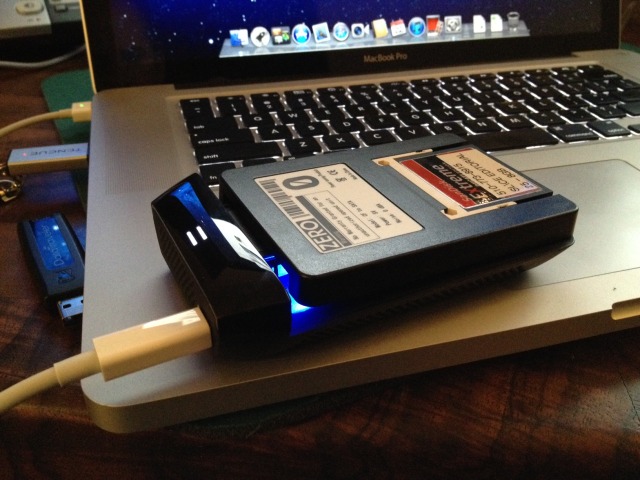Thunderbolt CF Card Reader Results.
 Sunday, July 22, 2012 at 10:45PM
Sunday, July 22, 2012 at 10:45PM Well… if you are a regular listener to the Digital Convergence Podcast that I co-host with Carl Olson, or if you just happened to catch Episode 82 last week, you may have heard me mention a solution that I found for a Thunderbolt CF Card Reader. Well, the little bugger came in the mail this weekend and I have the test results.

First off, let me tell you that I don’t recommend this solution so if your time is valuable you can move on, but if you want to know why, you can read the details.
The “reader” is really an after market CF to SATA adapter that comes in a cute little shell, the item can then be slide into a Seagate Go-Flex Thunderbolt cradle and you effectively have built an ad-hoc CF to thunderbolt card reader. (NOTE… i don’t know if I’m using the word “ad-hoc” properly there but I’m nearly 50 years old and eventually I had to use that word in a sentence and today seemed like a good day to give it a go).
There are a few problems with this configuration. 1. its hard to align the adpater into the cradle. 2. the cradle mount is too high so effectively the thing ‘floats’ in mid air, its very light so this isn’t that big of a deal but still… 3. once you put a card into the adapter, there is no release mechanism so, if you don’t have finger nails, good luck getting that little bugger out of there. But the number one reason why I don’t recommend this ‘solution’ is this… SPEED.
This gizmo actually was SLOWER then one of my older SanDisk Firewire 800 card readers. By much, no but it was slower
8GB of data transfer went like this:
Thunderbolt 3:30
Firewire 3:06
I’m not sure why this is the case, but there you have it. I appologize to the listeners that got excited about this “find” but if it makes any difference I was really excited too so now we ALL know how it feels to be disappointed. (PS, there’s no easter bunny either).

Reader Comments (4)
CF is effectively an IDE drive (it's electronically compatible). So your converter in this case is CF->IDE->SATA->Tunderbolt
Most CF cards won't read faster than about 66MB/s (MByte that is). The UDMA 6 ones can theoretically manage up to 133MB/s - which is still well below the design speeds of SATA2 and SATA3 - but actually top out at under 100MB/s in practice.
In your tests you were getting about 40-50MB/s would is what you'd expect from "slow" CF cards. You may do better with a very high speed card like Lexar's 600x range, but then again you may not. It's possible the IDE->SATA part of your adaptor is not supporting the higher UDMA levels.
http://www.lexar.com/products/lexar%C2%AE-professional-600x-compactflash%C2%AE-cf-card?category=77
CFast cards (which have never been widely adopted) are built on SATA.
Seriously?
Flickr has 82,675,545 Canon 5D mkII users. And growing fast is Canon 5D mkIII users at 3,910,592. Canon 7D is 55,409,649 users. Original 5D is 49,216,318. Various 1D model is at 28,369,437. EOS 20D 47,622,663, EOS 30D 41,999,834, EOS 40D 72,161,014, and EOS 50D 43,981,378.
Flickr via EXIF data has gathered 425,346,430 cameras on their site.
I could be 100 million off in my math and my point is still clearly made. And that is only Flickr data.
Compact Flash cards have been widely adopted and used -- 425 million cameras that needed a card put in them...and who buys only one?
The point is "CFast"
I'm guessing here that CFast cards are not the same as CF cards
They are a type of cf card which are faster.